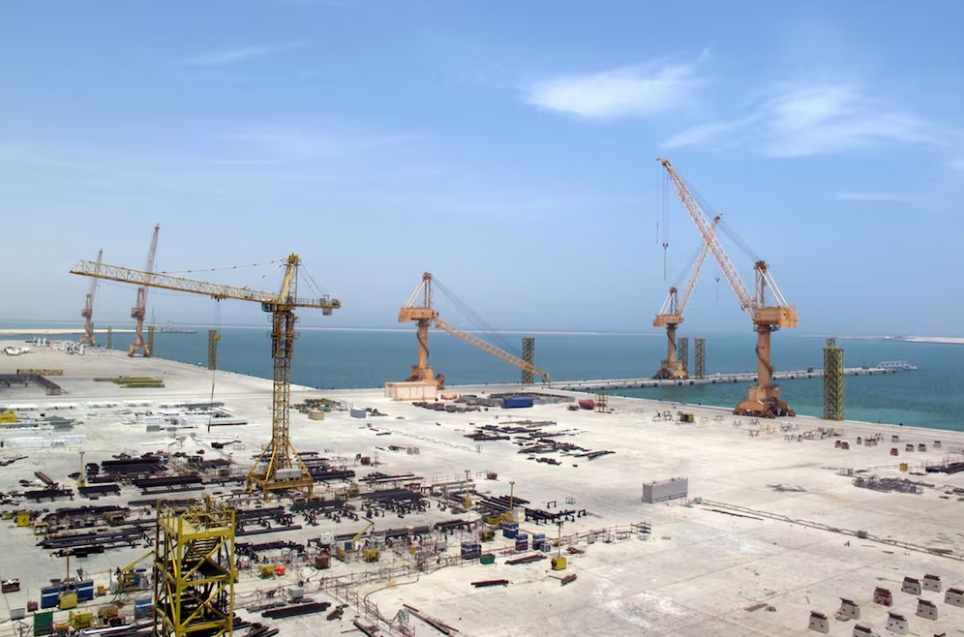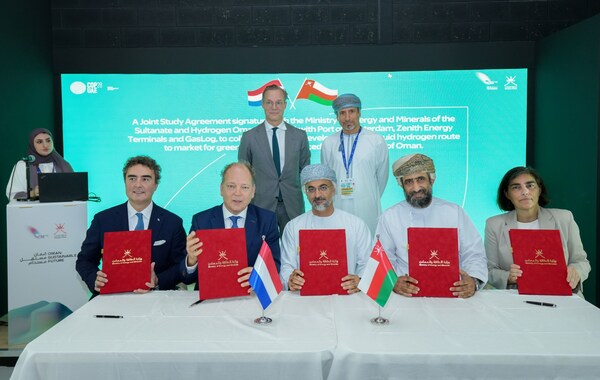
The sultanate, better known as an oil exporter and a regional tourist destination, is developing several large green hydrogen projects that aim to decarbonise its industries and export low-carbon ammonia to other markets.
Green hydrogen is produced through a process called electrolysis, in which water is split into hydrogen and oxygen using electricity generated from renewable sources.
Oman's location, coupled with its abundant solar and wind energy resources and vast land availability, makes it an ideal candidate to produce the low-carbon gas.
"Oman boasts some of the world's most suitable locations for solar and wind power generation, key ingredients for producing low-cost green hydrogen through electrolysis," Andrea Zanon, chief executive of WeEmpower Capital, told The National.
"This green hydrogen can then be transported through Oman's existing 4,000km gas pipeline network, significantly reducing infrastructure costs compared to starting from scratch.
"Furthermore, Oman's extensive experience in processing and exporting liquefied natural gas (LNG) and ammonia translates directly to efficiently managing green hydrogen and its derivatives."
The sultanate, which is the second-largest LNG exporter in the Middle East after Qatar, aims to produce at least a million tonnes of renewable hydrogen a year by 2030 before increasing capacity to 3.75 million tonnes by 2040.
By 2050, Oman plans to have a green hydrogen capacity of 8.5 million tonnes, greater than Europe's current hydrogen demand of about 8 million tonnes.

The International Energy Agency expects the Gulf country, which sits on key trade routes between Europe and Asia, to become the sixth-largest exporter of hydrogen globally and the largest in the Middle East by 2030.
Europe and Australia will collectively represent nearly 50 per cent of production for all green hydrogen projects scheduled for 2030, the Paris-based agency has said.
The biggest game-changer in Oman's hydrogen sector came last year when Hydrom, a state-run company, signed six agreements worth $51 billion to invest in green hydrogen projects. These were signed with companies from Belgium, the Netherlands, the UK, Japan, Singapore, Germany, India, Kuwait and the UAE.
"These investments were the results of almost a decade of negotiations and tech development, which now give Oman a big regional first-mover advantage," Mr Zanon said.
Projects under development
One of the projects in the pipeline is Hyport Duqm, a joint venture between Belgium’s DEME Group and Oman’s state energy company OQ.
In its recently published annual report, DEME said the project would be among the first globally to produce green hydrogen and ammonia. The company aims to kick-start its next stage of development this year, following a project development agreement signed with Oman's national hydrogen company, Hydrom, last year.
It was not clear whether the companies had accelerated the timeline for completing the project. Hyport Duqm and OQ were not immediately available for a comment.
Hyport Duqm previously announced that the first phase would produce more than 50,000 tonnes of green hydrogen annually by 2029, resulting in about 330,000 tonnes of ammonia output. In the second phase of the project, green ammonia production is expected to reach 650,000 tonnes.
The facility will utilise 1.3 gigawatts of combined wind and solar energy in the first phase, potentially increasing to more than 2.7 gigawatts in the second phase.
Meanwhile, Green Energy Oman (GEO), one of the largest green hydrogen projects proposed in the sultanate, is scheduled to begin operations in the early part of the next decade.
The project, developed by an international consortium with Shell as its lead operating partner, is expected to produce 1.8 million tonnes a year of hydrogen at full capacity, the London-based oil major said in its Energy Transition Strategy report.
GEO will produce hydrogen from seawater. The project will be powered by up to 25 gigawatts of solar and wind energy.
Initial challenges
Despite hydrogen’s growing potential, critics within the energy industry have underlined its high cost of production and the absence of a well-established market.
Trading hydrogen through short-term contracts in a way similar to commercial crude oil and LNG is "a challenge", given the long-term nature of investment required for projects, Frank Wouters, chairman of the Mena Hydrogen Alliance, told The National in an interview in February.
Mr Wouters, former deputy director general at the International Renewable Energy Agency (Irena), said "decoupling" the supply of hydrogen from demand through a strategic reserve would help create liquidity in the market.
"Let's say we create a strategic reserve of 5 million tonnes, so then immediately you have a pool to feed into," he said. "All the producers can first fill that reserve [and] it's not money out the door because you can also sell out of it."
But the more immediate challenge facing the industry is green hydrogen's much higher cost of production compared with fossil fuel-based energy sources.
In parts of the Middle East, Africa, Russia, and the US, green hydrogen production costs can range from $3.23 per kilogram to $5.38 per kilogram, while in Europe, it can cost as much as $8.60 per kilogram, according to estimates from PwC and the Boston Consulting Group.
Currently, almost most all hydrogen produced worldwide is "grey", which means it is produced from natural gas. The production of grey hydrogen costs only around $1.08 to $2.15 per kilogram, but the process is significantly more carbon-intensive.
"There's still a cost gap and we need to stimulate the market like we did for renewables until it's cost competitive. The governments need to do an extra step," Mr Wouters said.
In the oil-rich Gulf region, solar energy has become highly competitive in recent years, thanks to supportive government policies and falling equipment costs. This has paved the way for green hydrogen.
At less than 2 cents per kilowatt hour, solar PV is the cheapest option for electricity production in the Gulf, outpacing natural gas, liquefied natural gas, oil, coal and nuclear power, according to the Irena.
“Plummeting generation costs and abundant solar and wind resources in the region open the door for innovative energy technologies, such as green hydrogen, to be produced competitively,” the Abu Dhabi-based agency said in a December report.
Although there are several projects in the pipeline, renewables accounted for only 3 per cent of the GCC region's electricity generation capacity in 2022, with installed renewable power capacity reaching 5.6 gigawatts, the Irena report said.
Renewable capacity in the region needs to increase to almost 40 to 60 gigawatts – a nearly 60-fold rise – by 2030 to meet the region’s hydrogen targets, according to the Middle East Institute.
"The success of Oman's plans hinges on the global market's appetite for hydrogen," Mr Zanon said. "Favourable carbon pricing, particularly in Europe, for instance, would incentivise countries to import green hydrogen.
"Additionally, Oman faces competition from other green hydrogen producers, including Saudi Arabia and the UAE, making cost competitiveness a crucial piece of the Omani advantage."
Even as regional competition heats up, Oman is on track to supply more than 60 per cent of the total hydrogen exports from the Middle East by the end of the decade, the IEA said.

The sultanate will be followed by the UAE, which is expected to account for 20 per cent of the exports, and Saudi Arabia, with a 16 per cent market share.
Saudi Arabia, the Arab world's largest economy, is investing heavily in renewable energy projects as part of its plan to diversify from crude exports.
The kingdom is developing the $8.4 billion Neom green hydrogen project, which will integrate up to 4 gigawatts of solar and wind energy to produce up to 600 tonnes per day of carbon-free hydrogen by the end of 2026 in the form of green ammonia.
Meanwhile, the UAE is planning to build at least two hydrogen production hubs, or oases, by 2031. The Emirates aims to produce 1.4 million tonnes of hydrogen annually by that year.
The global hydrogen trade is projected to generate more than $280 billion in annual export revenue by 2050, with North Africa expected to benefit the most due to its high export potential, according to Deloitte.
Mr Wouters said the conversation around green hydrogen had become “more nuanced” in recent years, with countries finding applications for the fuel in their own industries.
“Part of the recent thinking is also looking at domestic use of hydrogen, and that could have many forms,” he said. “You could use hydrogen in traditional ways where you use hydrogen to get sulphur out of fuels, but you can also produce green steel with hydrogen."
Oman is developing a $3 billion green steel plant in a special economic zone, in the southern port city of Duqm.
The project, which is expected to process five million tonnes of steel a year, will cater to the automotive, electrical tools and wind turbine industries.
Renewables pivot
Oman aims to achieve net-zero emissions by 2050 but the country's transition to clean energy is also motivated by challenges in its oil and gas industry.
The country's economy remains dependent on the oil sector, which accounts for about 30 per cent of its GDP, 60 per cent of goods exports and 75 per cent of government revenue.
While natural gas has fuelled Oman's economic growth, its resources are now showing signs of depletion. At the same time, the increasing uptake of electric vehicles and solar energy is pushing peak oil demand into view.
"While short term [oil] production will increase revenue, Oman has an incentive to continue to be the first mover in clean energy development as it does not have the cheap oil and gas resources to fuel its economy and employ its young population," Mr Zanon said.
"Oman will continue to invest in its expansion of its ammonia export infrastructure and electrolysis, sending a strong market signal to consumers and hydrogen partners."
Oman’s aim to expand domestic green hydrogen production could support its GDP, fiscal revenue and the balance of payments over the long term, Fitch Ratings said in a report in December.
The sultanate's economy is estimated to have grown by 1.3 per cent last year, down from 4.3 per cent in 2022, due to Opec+ oil production cuts, the International Monetary Fund said in November.







